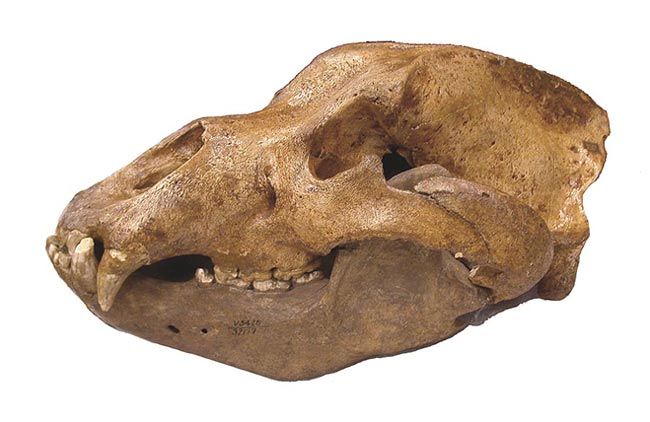Newfound Carnivores of the Caveman Era

Our ancestors had lots of predators and competitors to worry about — saber-toothed cats, dire wolves and even giant man-eating birds of prey.
Now you can add cave bears to that list. These prehistoric giants were roughly a third larger than modern grizzly bears.
Previously scientists thought cave bears were just vegetarians, evoking an image of gentle giants that fed solely on berries and roots. Now bones from the Carpathians — the mountains where Dracula supposedly dwelt — suggest cave bears could have also been carnivores, and possibly even cannibals.
Bad to the bone
Cave bears (Ursus spelaeus) are named after the places where their bones are commonly found — caves across Europe. They died out roughly 20,000 years ago, when ice dominated the Earth.
For the past 30 years, studies of their skulls, jaws and teeth suggested cave bears might have been largely herbivorous. In addition, the bones of central and western European cave bears matched those of vegetarians in having low levels of nitrogen-15, whose atomic nucleus has one more neutron than common nitrogen-14 does. Animals accumulate nitrogen-15 in their bodies, and animals that eat animals — that is, carnivores — build up more nitrogen-15 than herbivores do.
Still, black bears and brown bears are omnivores. This suggested that although some cave bears were largely vegetarian, others might have been more carnivorous.
Sign up for the Live Science daily newsletter now
Get the world’s most fascinating discoveries delivered straight to your inbox.
New data from the Pestera cu Oase ("Cave with Bones") in the southwestern tip of the Carpathian mountains in Romania now hints most of its cave bears were significantly carnivorous, due to their high nitrogen-15 levels.
Hidden caves
Retrieving the bones was not easy.
"It is a pretty inaccessible cave that you need to go underwater to get to," said researcher Michael Richards, an archaeologist at the Max Planck Institute for Evolutionary Anthropology at Leipzig, Germany.
The cave entrances the bears once used collapsed long ago, so one had to reach the bones through a lower level, going through an active spring and an underground river. To reach the Pe?tera cu Oase, which was discovered by inquisitive Romanian cavers, scuba equipment and climbing gear are necessary.
"On a daily basis, you can imagine that it meant a lot of very hard work for my small excavation team, and also that it was not exempt of some risk," said researcher Joao Zilhao, a Paleolithic archaeologist at the University of Bristol in England.
Bears vs. humans
The findings suggest these cave bears could have struggled over meat with humans and the other carnivores of the time — hyenas, wolves and cave lions — as well as omnivores such as brown bears.
"It would be interesting to measure more cave bears from other sites in this region to see if we find other carnivorous cave bears," Richards said. "It would also be interesting trying to determine why these bears were carnivores when other cave bears weren't."
The researchers suggest the cave bears might have eaten fish, but another possibility is "some degree of bear-bear cannibalism," said University of Arizona zooarchaeologist Mary Stiner, who did not participate in this study. In brown bears, "cannibalism and eliminating rivals and young go hand in hand, as in lions. This behavior is also clear from very large cave bear tooth marks on young cave bear skulls in Yarimburgaz Cave in western Turkey."
These results might also shed light on cave bear bones that humans and Neanderthals apparently placed in these caves in ancient times. These actions "are often interpreted as some sort of ritual or symbolic behavior, and I wonder if cave bears were particularly compelling for humans if they were also a competitor," Richards told LiveScience.
The international team of researchers detailed its findings online Jan. 7 in the journal Proceedings of the National Academy of Sciences.












